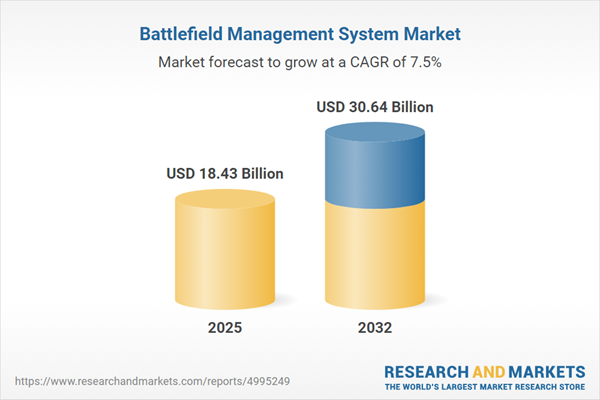Speak directly to the analyst to clarify any post sales queries you may have.
Battlefield management systems are reshaping defense coordination by enabling secure information sharing and dynamic command capabilities, particularly at an executive level. These integrated platforms drive modernization, enhance situational awareness, and support mission-critical decision-making for defense organizations adapting to new operational demands.
Market Snapshot: Battlefield Management System Market Outlook
The global battlefield management system market is on a clear growth trajectory, fueled by increased defense investments in digital transformation. In 2024, the market valuation stands at USD 17.17 billion, expected to rise to USD 18.43 billion in 2025 and progress to USD 30.64 billion by 2032. This steady compound annual growth rate of 7.50% highlights consistent demand for network interoperability, advanced command capabilities, and broad uptake of emerging defense technologies. Regional trends point to varying modernization approaches, but a shared commitment to optimizing operational performance in increasingly complex and dynamic threat landscapes.
Scope & Segmentation of the Battlefield Management System Market
This report provides actionable insight for senior leaders involved in procurement, digital transformation, and operational strategy within the defense sector. The segmentation and technology focus areas covered include:
- Platform: Airborne, land, and naval systems are foundational, offering adaptability to diverse mission environments and enabling tailored operational approaches.
- Component: Key elements include advanced sensors, encrypted communications, high-capacity networking, precision processors, and versatile software—all integral to mission-critical operations.
- End User: System architectures are designed to support armies, navies, air forces, and specialized units, facilitating coordination for joint and stand-alone missions.
- Application: Critical functions span command and control, intelligence gathering, surveillance, reconnaissance, and secure information exchange, accelerating response cycles and mission accuracy.
- Deployment Mode: Flexible deployment through on-premise and cloud-based options supports scalability, compliance with evolving regulations, and meeting specific security requirements.
- Regional Focus: The Americas drive robust network resilience strategies; EMEA prioritizes collaborative integration with an eye on regulatory harmonization; Asia-Pacific propels digital transformation for rapid modernization and technology adoption.
- Company Coverage: Industry leaders—including Lockheed Martin, Northrop Grumman, Raytheon, Elbit Systems, Thales, Leonardo, BAE Systems, Rafael, Saab, and Hensoldt—prioritize technological innovation, strategic alliances, and integration to align with defense trends.
- Key Technologies: Artificial intelligence supports operational planning and elevates situational awareness; advanced network security establishes secure, multi-domain operations; edge computing brings real-time analytics directly to the tactical field for immediate action.
Key Takeaways: Strategic Considerations for Senior Leaders
- Analytics and artificial intelligence facilitate more agile and adaptive mission planning, ensuring organizations can react to rapidly shifting scenarios and enhance operational outcomes.
- Investing in modular and scalable system architectures allows organizations to implement upgrades in phases, minimizing disruption and maximizing long-term platform value.
- Consistent focus on cybersecurity frameworks is crucial for maintaining secure collaboration across agencies and allied forces while supporting compliance mandates.
- Tailored system deployment according to environmental and operational variables strengthens information flow and supports continuous, reliable decision cycles.
- Flexible infrastructure investments help organizations adjust swiftly to evolving compliance and threat requirements, sustaining operational effectiveness.
- Diversification of supplier and procurement channels positions defense organizations to manage interruptions and regulatory changes, maintaining mission continuity and organizational stability.
Tariff Impact
With new U.S. tariffs expected in 2025, defense procurement and supply chain strategies are adapting. Organizations are diversifying supplier relationships and increasing domestic contracting, ensuring resilience in operations and readiness for shifting regulations. These measures are essential to secure uninterrupted delivery and compliance across major markets.
Methodology & Data Sources
This analysis draws from recent technical whitepapers, robust market datasets, and direct contributions from senior procurement officers and technology executives in the defense field. Findings have been reviewed by subject matter experts to offer practical, validated guidance for decision-makers.
Why This Report Matters
- Enables executives to allocate resources effectively and advance digital transformation programs critical to modernization and organizational resilience.
- Supports compliance and operational reliability, even as global regulations and geopolitical influences present new challenges.
- Guides procurement and partnership strategies that reinforce readiness and maintain sustainable advantages in defense operations.
Conclusion
This report empowers defense decision-makers to leverage digital integration and modern battlefield management systems to achieve evolving mission objectives. Prepare your organization for sustained excellence and resilience in a dynamic operational environment.
Additional Product Information:
- Purchase of this report includes 1 year online access with quarterly updates.
- This report can be updated on request. Please contact our Customer Experience team using the Ask a Question widget on our website.
Table of Contents
3. Executive Summary
4. Market Overview
7. Cumulative Impact of Artificial Intelligence 2025
Companies Mentioned
The companies profiled in this Battlefield Management System market report include:- Lockheed Martin Corporation
- Northrop Grumman Corporation
- Raytheon Technologies Corporation
- Elbit Systems Ltd.
- Thales Group
- Leonardo S.p.A.
- BAE Systems plc
- Rafael Advanced Defense Systems Ltd.
- Saab AB
- Hensoldt AG
Table Information
| Report Attribute | Details |
|---|---|
| No. of Pages | 199 |
| Published | October 2025 |
| Forecast Period | 2025 - 2032 |
| Estimated Market Value ( USD | $ 18.43 Billion |
| Forecasted Market Value ( USD | $ 30.64 Billion |
| Compound Annual Growth Rate | 7.5% |
| Regions Covered | Global |
| No. of Companies Mentioned | 11 |









